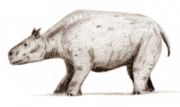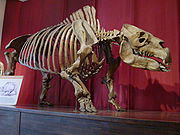
Toxodon
Encyclopedia
Toxodon is an extinct mammal of the late Pliocene
and Pleistocene
epochs about 2.6 million to 16,500 years ago. It was indigenous to South America, and was probably the most common large-hoofed mammal in South America at the time of its existence.
Charles Darwin
was one of the first to collect Toxodon fossils, after paying 18 pence for a T. platensis skull from a farmer in Uruguay. In The Voyage of the Beagle Darwin wrote "November 26th - I set out on my return in a direct line for Monte Video. Having heard of some giant's bones at a neighbouring farmhouse on the Sarandis, a small stream entering the Rio Negro, I rode there accompanied by my host, and purchased for the value of eighteen pence the head of an animal equalling in size that of the hippopotamus. Mr Owen in a paper read before the Geological Society, has called this very extraordinary animal, Toxodon, from the curvature of its teeth." Since Darwin discovered that the fossils of similar mammals of South America were different than those in Europe, he invoked many debates about the evolution and natural selection of animals.

 Toxodon was about 2.7 metres (8.9 ft) in body length, and about 1.5 metres (4.9 ft) high at the shoulder and resembled a heavy rhinoceros
Toxodon was about 2.7 metres (8.9 ft) in body length, and about 1.5 metres (4.9 ft) high at the shoulder and resembled a heavy rhinoceros
, with a short and vaugly hippopotamus
-like head. Because of the position of its nasal openings, it is believed that Toxodon had a well-developed snout. It had a massive skeleton, which suggests that it supported a large muscular body. It had short stout legs with three functional toes, with most of the body weight being borne by the central toe.
The vertebrae were equipped with high apophyses, which most likely supported the massive weight and muscles as well as its powerful head. Toxodon had broad jaws which were filled with bow shaped teeth and incisors. These teeth would have allowed the animal to tear through and bite off the plants and leaves.
It was initially believed to have been amphibious, but after examining the proportions of the femur
and tibia
, as well as the position of its head, below the top of the spinal column, palaeontologists realised that it had features similar to terrestrial animals such as elephants or rhinoceroses. The fossils are also usually found in arid and semi-arid areas, typically an indication of a primarily terrestrial life.
Toxodon would have had a very unusual gait, due to it's peculiar proportions. It may have galloped to escape predators, but like a rhino, it proboably relied more on it's size as protection against predators.
 Toxodon became extinct at the end of the Pleistocene. Many Toxodon fossils have been found accompanied by arrow heads. This shows that prehistoric humans hunted them, which could have been a leading cause of their demise.
Toxodon became extinct at the end of the Pleistocene. Many Toxodon fossils have been found accompanied by arrow heads. This shows that prehistoric humans hunted them, which could have been a leading cause of their demise.
, Toxodon are depicted as herd animals that wallow in the water like hippopotami, despite the modern consensus that they did not swim. Nigel Marvin, the main character in Prehistoric Park
drives alongside a group of Toxodon
in a jeep. It is very unlikely that Toxodon
could run as fast as a jeep, due to their small front legs and heavey disposition. The show also depicts Toxodon as being the prey for a single smilodon
. This is unlikely; a comperable analogy using modern day creatures would be a jaguar or leopard attacking a rhino or hippo, no combination of which has ever been oberved in nature. Toxodon was also one of the many prehistoric animals encountered in the uncharted plateau that is the setting of Arthur Conan Doyle's The Lost World
Pliocene
The Pliocene Epoch is the period in the geologic timescale that extends from 5.332 million to 2.588 million years before present. It is the second and youngest epoch of the Neogene Period in the Cenozoic Era. The Pliocene follows the Miocene Epoch and is followed by the Pleistocene Epoch...
and Pleistocene
Pleistocene
The Pleistocene is the epoch from 2,588,000 to 11,700 years BP that spans the world's recent period of repeated glaciations. The name pleistocene is derived from the Greek and ....
epochs about 2.6 million to 16,500 years ago. It was indigenous to South America, and was probably the most common large-hoofed mammal in South America at the time of its existence.
Charles Darwin
Charles Darwin
Charles Robert Darwin FRS was an English naturalist. He established that all species of life have descended over time from common ancestry, and proposed the scientific theory that this branching pattern of evolution resulted from a process that he called natural selection.He published his theory...
was one of the first to collect Toxodon fossils, after paying 18 pence for a T. platensis skull from a farmer in Uruguay. In The Voyage of the Beagle Darwin wrote "November 26th - I set out on my return in a direct line for Monte Video. Having heard of some giant's bones at a neighbouring farmhouse on the Sarandis, a small stream entering the Rio Negro, I rode there accompanied by my host, and purchased for the value of eighteen pence the head of an animal equalling in size that of the hippopotamus. Mr Owen in a paper read before the Geological Society, has called this very extraordinary animal, Toxodon, from the curvature of its teeth." Since Darwin discovered that the fossils of similar mammals of South America were different than those in Europe, he invoked many debates about the evolution and natural selection of animals.
Description


Rhinoceros
Rhinoceros , also known as rhino, is a group of five extant species of odd-toed ungulates in the family Rhinocerotidae. Two of these species are native to Africa and three to southern Asia....
, with a short and vaugly hippopotamus
Hippopotamus
The hippopotamus , or hippo, from the ancient Greek for "river horse" , is a large, mostly herbivorous mammal in sub-Saharan Africa, and one of only two extant species in the family Hippopotamidae After the elephant and rhinoceros, the hippopotamus is the third largest land mammal and the heaviest...
-like head. Because of the position of its nasal openings, it is believed that Toxodon had a well-developed snout. It had a massive skeleton, which suggests that it supported a large muscular body. It had short stout legs with three functional toes, with most of the body weight being borne by the central toe.
The vertebrae were equipped with high apophyses, which most likely supported the massive weight and muscles as well as its powerful head. Toxodon had broad jaws which were filled with bow shaped teeth and incisors. These teeth would have allowed the animal to tear through and bite off the plants and leaves.
It was initially believed to have been amphibious, but after examining the proportions of the femur
Femur
The femur , or thigh bone, is the most proximal bone of the leg in tetrapod vertebrates capable of walking or jumping, such as most land mammals, birds, many reptiles such as lizards, and amphibians such as frogs. In vertebrates with four legs such as dogs and horses, the femur is found only in...
and tibia
Tibia
The tibia , shinbone, or shankbone is the larger and stronger of the two bones in the leg below the knee in vertebrates , and connects the knee with the ankle bones....
, as well as the position of its head, below the top of the spinal column, palaeontologists realised that it had features similar to terrestrial animals such as elephants or rhinoceroses. The fossils are also usually found in arid and semi-arid areas, typically an indication of a primarily terrestrial life.
Toxodon would have had a very unusual gait, due to it's peculiar proportions. It may have galloped to escape predators, but like a rhino, it proboably relied more on it's size as protection against predators.
Extinction

In popular culture
In the ITV series Prehistoric ParkPrehistoric Park
Prehistoric Park is a six-episode mockumentary television mini-series that premiered on ITV on 22 July 2006 and on Animal Planet on 29 October 2006. The program was produced by Impossible Pictures, who also created Walking with Dinosaurs. In 2007, ITV cancelled Prehistoric Park, but introduced the...
, Toxodon are depicted as herd animals that wallow in the water like hippopotami, despite the modern consensus that they did not swim. Nigel Marvin, the main character in Prehistoric Park
Prehistoric Park
Prehistoric Park is a six-episode mockumentary television mini-series that premiered on ITV on 22 July 2006 and on Animal Planet on 29 October 2006. The program was produced by Impossible Pictures, who also created Walking with Dinosaurs. In 2007, ITV cancelled Prehistoric Park, but introduced the...
drives alongside a group of Toxodon
Toxodon
Toxodon is an extinct mammal of the late Pliocene and Pleistocene epochs about 2.6 million to 16,500 years ago. It was indigenous to South America, and was probably the most common large-hoofed mammal in South America at the time of its existence....
in a jeep. It is very unlikely that Toxodon
Toxodon
Toxodon is an extinct mammal of the late Pliocene and Pleistocene epochs about 2.6 million to 16,500 years ago. It was indigenous to South America, and was probably the most common large-hoofed mammal in South America at the time of its existence....
could run as fast as a jeep, due to their small front legs and heavey disposition. The show also depicts Toxodon as being the prey for a single smilodon
Smilodon
Smilodon , often called a saber-toothed cat or saber-toothed tiger, is an extinct genus of machairodonts. This saber-toothed cat was endemic to North America and South America, living from near the beginning through the very end of the Pleistocene epoch .-Etymology:The nickname "saber-tooth" refers...
. This is unlikely; a comperable analogy using modern day creatures would be a jaguar or leopard attacking a rhino or hippo, no combination of which has ever been oberved in nature. Toxodon was also one of the many prehistoric animals encountered in the uncharted plateau that is the setting of Arthur Conan Doyle's The Lost World
External links
- http://www.toyen.uio.no/palmus/galleri/montre/english/a31962_63.htm Toxodon platensis - brief description and fossil skull

